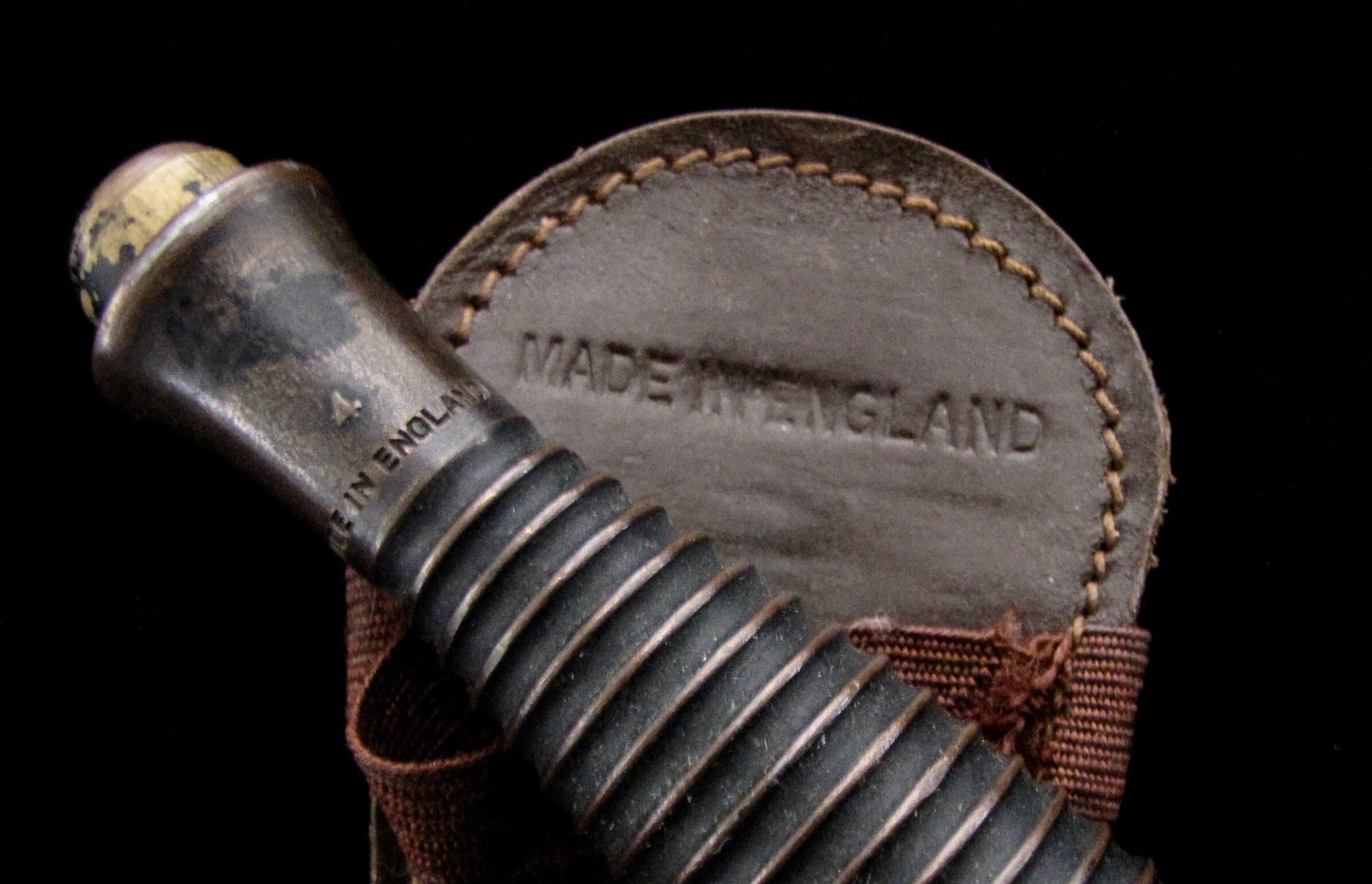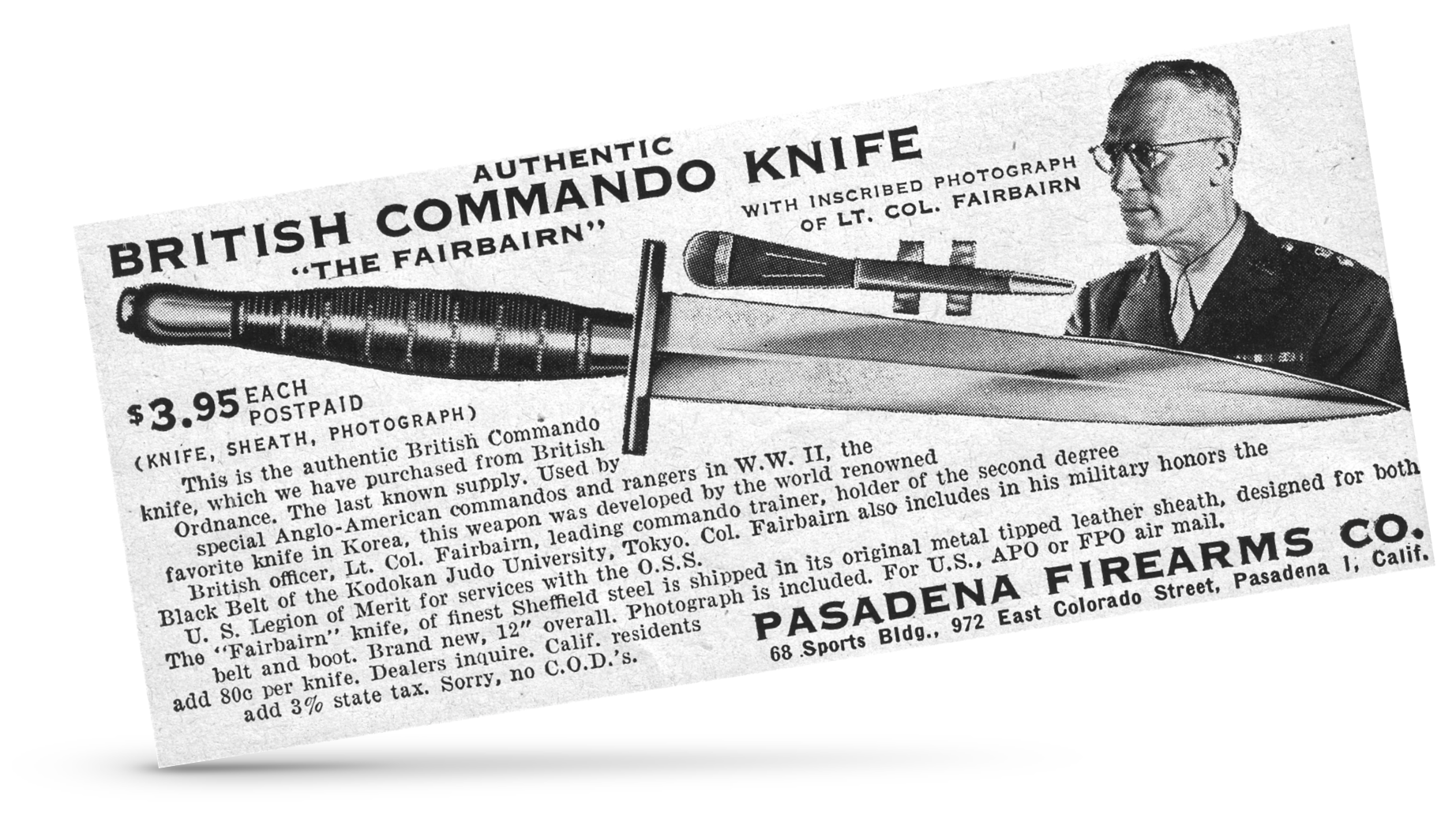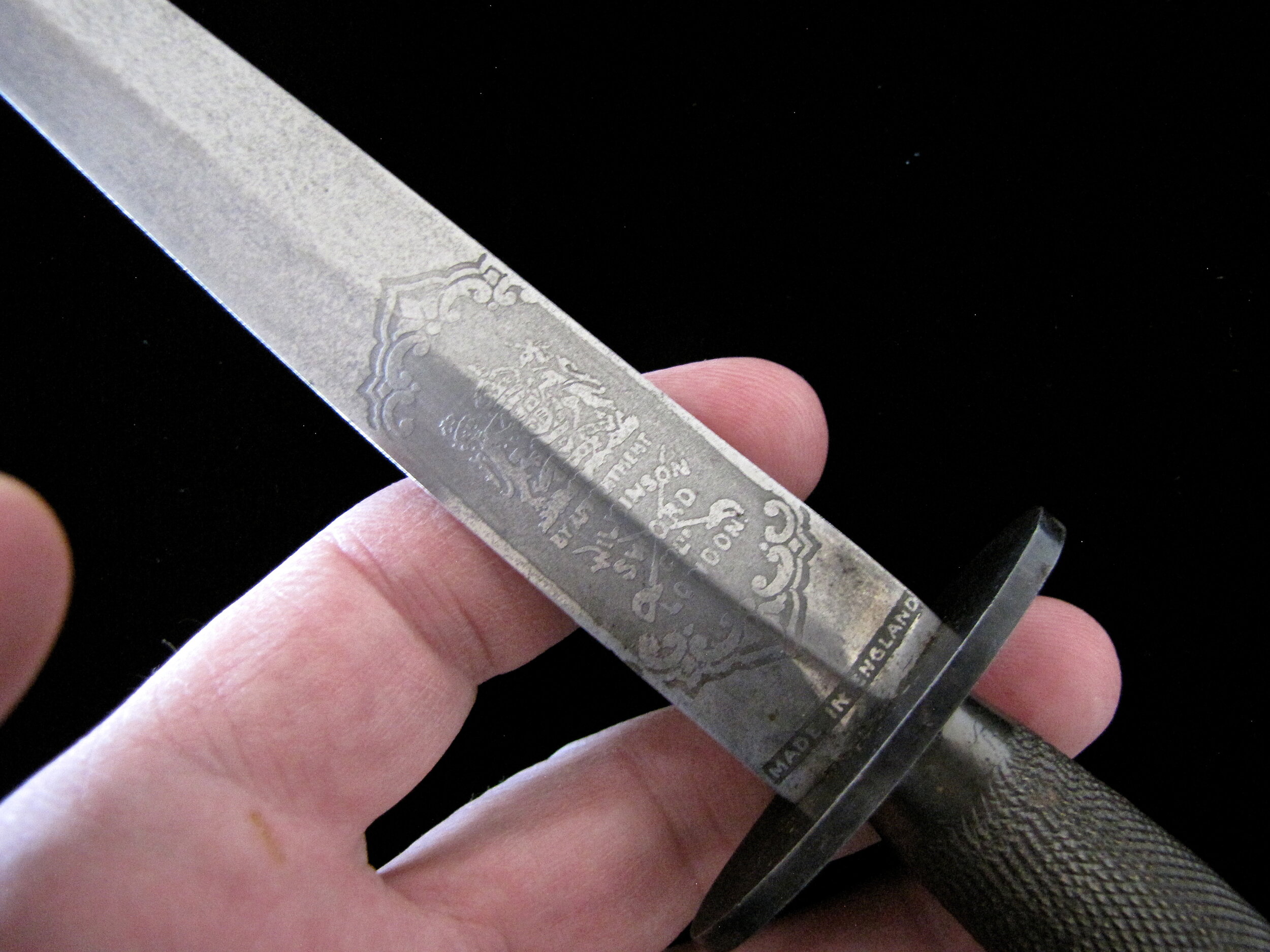The McKinley Tariff Act Of 1890
The Story Behind Why Some F-S Knives Are Marked ‘ENGLAND’
By
Roy Shadbolt
Introduction
This stunning Ribbed & Beaded F-S Knife complete with original and correct scabbard is typical of the type of late-war F-S that was sold post-war into the US market. As per US import requirements both the scabbard and knife were stamped with the country of origin ‘England’. Although never actually issued, for the collector looking for an original knife in high condition, such examples represent a splendid opportunity.
A common mark found on most patterns and variations of the wartime produced F-S Knife and their associated scabbards is the single word ‘ENGLAND’. On rare occasions one can encounter ‘MADE IN ENGLAND’ and then of course there is the well known mark ‘SHEFFIELD’ (sometimes ‘SHEFFIELD ENGLAND), this last mark is rare on wartime knives but common on post-war knives. The meaning of these stamps and their implication for the F-S collector is often perplexing and has resulted in some confusion and misunderstanding. The following article will explain the reasoning behind such marks, the difference between the three and the implications this has for the collectors.
Historical Perspective
The origin of these stamps stems back to the late nineteenth century, some fifty years before the introduction of the Fairbairn-Sykes Fighting Knife, and is applied to much more than just the F-S Fighting Knife. Perhaps some historical perspective is needed before we look more specifically at what this means for today’s F-S collector.
William McKinley
In the last decade of the 19th century, the Ohio Republican Senator William McKinley sponsored an act to increase the tariff on imported goods. This act, which became law on October 1st, 1890, was a misguided attempt to protect US industry from its foreign competitors and the inexpensive products which were finding their way into the domestic market. This new tax would become known as the McKinley Tariff and would apply an import duty to some products, occasionally as high as 49%. Ultimately the whole concept proved flawed and became widely unpopular, resulting in the act lasting little more than four years.
So why is this of any interest to the F-S collector? Although this import tax was short-lived, one small but enduring element was that those goods made outside of the US had to be prominently marked with their country of origin prior to their entry into the United States. This requirement is still in use today.
Knives Marked ‘SHEFFIELD’
A splendid Second Pattern F-S Knife manufactured by John Clarke of Sheffield and fully marked with their details.
Out of the three types of import marks discussed here, the ‘SHEFFIELD’ stamp is the one that probably causes the most confusion or at least is the most often misunderstood. British knife makers have been using versions of the mark going back to the 19th Century and understandably some F-S makers continued to use this mark during their production throughout the Second World War (and well beyond into modern production). Sometimes of course ‘SHEFFIELD’ was contained within their standard company trade logo and stamp, as in the two cases to be discussed here. John Clarke & Son and William Rodgers are two good examples of this. However, extreme caution must be observed when trying to place a knife within the wartime production period, especially where Rodgers is concerned, as the overwhelming majority of F-S Knives that carry such a mark by this marker are not of wartime production but much later and certainly post-war. As a general rule of thumb, one could be forgiven for employing the rule that if ‘SHEFFIELD’ is marked on an F-S Knife, then 99.9% of this time it will likely be of post-war construction.
John Clarke & Son Sheffield
J. Clarke & Son is as far as I am able to ascertain the earliest makers mark to include the word ‘SHEFFIELD’ within their marking of F-S Knives. Fortunately for us they were thoughtful enough to also include a date whithin their company logo, that date being 1942. These early Clarke Second Pattern knives are very rare and understandably desirable. Clarke though did not mark all of their knives as there are many examples of totally correct knives by Clarke that do not carry their company marking.
An excessively rare Third Pattern marked J. Clarke & Son Sheffield.
When in 1943 the standard Government F-S Pattern changed to the Third (Pattern), Clarke switched over to the updated design and continued to fulfill official MoS contracts. During 1943/4 they completed three contracts with the total quantity of knives supplied being 31,044 units. Interestingly only a handful of Third Pattern knives with their makers mark on have been noted, the conclusion being that for some unknown reason (time perhaps) that the overwhelming majority of Clarke Third Pattern F-S Knives are thus unmarked.
William Rodgers Sheffield England
A Wooden (Fat) Gripped F-S variation supplied to the RAF but this example is especially interesting and rare as it has the stamp of ‘WILLIAM RODGERS SHEFFIELD’ on the wooden grip.
Just to be very clear and so there is no misunderstanding, almost every example of an F-S Knife that one will encounter that is stamped ‘WILLIAM RODGERS SHEFFIELD ENGLAND’ (or some version of this mark) will almost certainly be post-war and NOT wartime production. This company has produced vast amounts of F-S Knives right up to the present day and all seem to be marked with their company logo. It is true to say that Rodgers did indeed supply the MoS with officially contracted knives and on the 19th March 1943 fulfilled a contract totaling 4,000 units. However and like Clarke, it would seem the vast majority of their knives remain unmarked, with only a very small handful of wartime examples surfacing with their company mark.
The ‘ENGLAND’ Stamp & The Rarer ‘MADE IN ENGLAND’ Stamp
A really very rare example of the ‘full’ (MADE IN ENGLAND) import stamp applied to the frog of the scabbard and ‘around’ the pommel area of the F-S knife. This was almost certainly the first attempt at marking knives with an import stamp and clearly it was soon realized that a simpler solution had to be found.
The most prolific stamp one will encounter and the main motivation behind writing this article is the often seen ‘ENGLAND’ stamp encountered on the crossguard of F-S Knives (and their associated scabbards). This stamp was applied to hundreds of thousands of F-S Knives post-war as they were imported into the US commercial market, being sold as surplus by the British Government. Of course such markings were not restricted to F-S Knives only, as one can find Enfield rifles and Webley revolvers with an identical marking (as well as many other items).
One interesting anomaly regarding the US import stamp is that a few knives have surfaced that have a ‘MADE IN ENGLAND’ stamp. Due to the size this is found applied to the pommel area and carefully marked ‘around’ that area of the hilt. This must had required a reasonable amount of skill and extra time to apply. In comparison to the thousands of standard ‘ENGLAND’ marks one sees the former and longer marking is excessively rare with only a very few examples known. Logic dictates that perhaps whoever was tasked with marking these knives started off with the longer mark around the pommel and it soon became clear that with hundreds of thousands of knives to mark, this simply wasn’t going to be practical, so the decision was made to shorten this to just ‘ENGLAND’ and apply it to the flat surface of the crossguard.
What Does This Mean For Todays F-S Collector?
Just one example of the many advertisements one could find in such magazine as Popular Mechanics through the 1950’s advertising ‘The British Commando Knife’. This example shows a Ribbed & Beaded variation of which there must have been many such knives within the surplus purchase as today it’s hard to find a R&B F-S ‘without’ the England import stamp.
So now here we are, many decades after the fact and collecting the F-S Fighting Knife...so what, if anything, does having the import stamp on an F-S Knife mean for today’s collector?
Well actually there is quite a lot that we can glean from this mark or the lack thereof. Firstly, it’s worth noting that some collectors will not choose to have knives in their collection that are marked ‘England’. The logic being that these knives were never issued and sat out the war in stores only to be sold as surplus after the war’s end. I can certainly understand this train of thought and cannot find fault with this logic, although I personally do not subscribe to this mindset. These knives, by having the England mark, clearly demonstrate that they were indeed of WWII production. The fact that they were not issued means that many are in very fine condition, leaving us with many examples still in great shape and as we all know, ‘condition’ is often a primary consideration when collecting. But for the collector who chooses the path of not collecting England-marked knives, this is a personal choice and one which I certainly don’t wish to criticize. We all have different tastes and preferences and that makes for some very interesting and unique collections.
From a novice collector’s perspective the ‘ENGLAND’ stamp is very helpful. If a knife carries this marking we know for sure that it was originally in British military stores at war’s end (1945). Although subsequently imported into the US as surplus and sold on the civilian market, it does NOT change the fact that this is a completely genuine war-time British production F-S Fighting Knife. It is also worth pointing out that both the knife AND scabbard should be marked England as if one is missing this mark it may be a sign that they are not original to each other. I personally see no problem with having England-marked knives in a collection and have owned many fine examples. When all is said and done I feel the important factors are that the knife & scabbard are genuine.
Poor Memory, Stories Or Just Plain Fantasy
Examples of the many post-war commercial advertisement in popular magazine that made the F-S Knife available to whomever wished to purchase examples.
Just one final thought on this topic. If you come across an F-S Knife marked ‘ENGLAND’ which is well-used, beat up and/or modified in any way, this was NOT done during WWII by some Commando who was fighting through Nazi-occupied Europe. I have heard the story countless times. I will be shown an ‘ENGLAND’ marked knife and the owner will say this came from their grandfather who “won it in a card game from a Commando in Britain just before he parachuted into France on D-Day”, etc. This just could not have happened as the knife was safely in stores until it was sold into the civilian US market. Let me share a great example of this which came my way some years ago.
I was contacted by a gentleman who wanted to know more about his father’s ‘Commando Dagger’. The F-S knife was indeed a lovely example of a Ribbed & Beaded variation complete with its original scabbard. His father had been a doctor during WWII and some time ago passed it onto his son. I explained that this was indeed an original and very nice example but must have been commercially purchased ‘after’ WWII and in the US. Somewhat confused, he said he would contact his father to check the details. Of course at this point I was a little nervous, as I had assumed his father was long gone by now and of course the gentleman was potentially going to challenge his father on whatever story he may have been told. As it turned out, I need not have worried. His father, who had not talked much about the war, was happy to share with his son some additional details. Apparently he had never even served overseas and had remained in the US serving as a doctor. He bought the knife post-war out of a magazine via one of the many advertisements as a memento of his WWII service.
The nice thing about this story is that father and son got to chat about a part of the past which they had not covered prior. In this case, there was no intention by the father to tell a war story, the son had simply made some innocent assumptions. This story illustrates that the ‘ENGLAND’ stamp can often provide us with valuable information but can also be confusing if not properly understood.
This rare Wilkinson ‘Masonic’ etched Second Pattern F-S Knife was produced by Wilkinson for VIP presentation purposes. The sharp-eyed will note a small banner etching at the ricasso that reads ‘MADE IN ENGLAND’. Not all Masonic knives are thus marked.
End Notes
Collecting the F-S Knife is and has always been a journey and an education. Examples that have some sort of formal marking applied to them have always fascinated me and in many ways have directed my own journey both in collecting, research and now in sharing this knowledge through writing. We do not have the full story of all markings and likely never will but through decades of diligent study and research and occasionally a little luck, our collective knowledge has grown exponentially. This alone has increased the interest and excitement of F-S collecting as (speaking for myself) when one knows more about our chosen passion, our understanding, fascination and enjoyment only multiplies. Knives that have some kind of formal marking such as those described earlier, indicate an intention or anticipation to export. This type of marking, how, where and when it was applied, to any pattern or variation of F-S, really adds new information, new details and more understanding to that knife. This must be and is a good think, as learning and understanding more about what is in our collection, can only benefit us and others.








